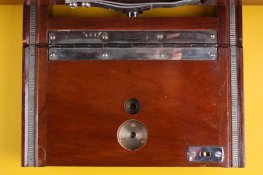An ultra simple way is to go to a hardware store, get a 1/4-20 nut, chisel a recess for it, and install in into the bottom of the camera (or a piece of wood, and then attach the piece of wood to the camera.
This is how I did it with my 12x20 pinhole. I carefully chiseled out a six-sided hole for a hex nut, from the back side, leaving about 3 or 4 mm of thickness in the bottom plate underneath the nut. I then glued a plug over the nut to retain it (though I did not glue the nut itself).
I suppose you could do just as well by drilling a simple circular hole that is a bit undersized, and then bashing a hex nut in with a hammer, and aligning it with a nail punch. Obviously, this should be done in a piece of wood separate from the camera, and then the wood should be attached to the camera.
There are other sorts of nuts aside from hex nuts too. I just got lazy.














